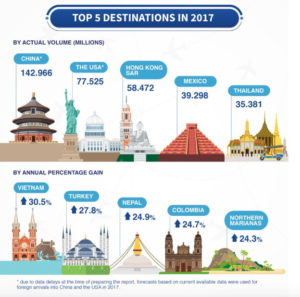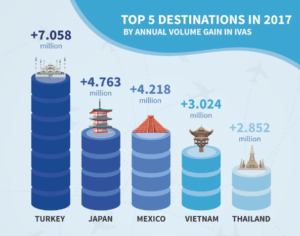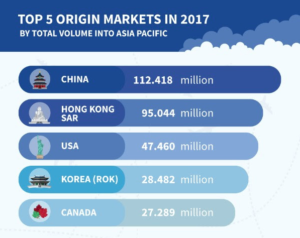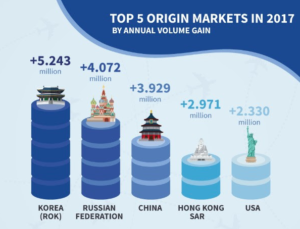Bangkok – With a cumulative count of 636 million foreign arrivals into the region in 2017, Asia Pacific sets a new record – according to a report released today by the Pacific Asia Travel Association (PATA).
Covering 47 destinations across the region with eight in the Americas, 15 in the Pacific and 24 across Asia, the PATA Annual Tourism Monitor 2018 Early Edition reviews foreign arrivals over the past five years in an effort to quantify the changing trends and patterns of international travel across the Asia Pacific region.
The distribution of these arrivals was such, that in terms of the destination regions and sub-regions covered in the report, Asia received the majority of these arrivals in 2017 with a 72% share, followed by the Americas with 24% and the Pacific with the remaining four percent. A similar distribution was seen for the additional volume of foreign arrivals generated into each region between 2016 and 2017.
At the single origin market level, the major suppliers of foreign arrivals into Asia Pacific destinations in 2017 were:
In total, 11 Asia Pacific destinations each received more than one million additional foreign arrivals into their respective destinations between 2016 and 2017. Only four of the 47 destinations reported declines in their inbound foreign arrival numbers, and these ranged from a minor loss of 4,000 arrivals to a much more significant contraction of nearly 3.9 million.
Overall however, the Asia Pacific region received nearly 35 million more foreign arrivals in 2017 than it did just one year earlier.
Intra-regional travel flows remained very strong for most Asia Pacific regions in 2017 with almost 94% of the foreign arrivals into Asia originating from within Asia itself. For the Americas, the intra-regional proportion of international travel was 78%.
The Pacific went against this trend however, with less than one-third (32%) of its foreign arrivals in 2017 originating from within the Pacific region; more than half (53%) of the foreign arrivals into the Pacific in that year came from Asian origin markets.
In terms of supplier markets into Asia Pacific in 2017, the vast majority of foreign arrivals came from Asia (62%), followed by the Americas (18%) and then Europe (12%). The Pacific supplied a little over two percent of the total arrivals into Asia Pacific in 2017, followed by Africa with less than one percent. A significant proportion of arrivals (5%) came from origin markets that were unspecified.
At the single origin market level, the major suppliers of foreign arrivals into Asia Pacific destinations in 2017 were:
In total, there were 14 origin markets that each generated in excess of 10 million arrivals into Asia Pacific in 2017. By additional volume of arrivals generated between 2016 and 2017 however, that order changed somewhat, with the top five origin markets delivering the most additional volume of foreign arrivals into Asia Pacific between 2016 and 2017 being ranked as:
PATA CEO Dr. Mario Hardy noted, ã2017 was yet another record year for the aggregate volume of foreign arrivals into Asia Pacific. Significant variability was once again evident with 30 of the 47 destinations covered in this report showing annual growth increases in excess of five percent ã in fact 17 of these were in the double-digit growth range, with only a few showing contractions. Overall, it was another very robust year for international travel within Asia Pacific. The link between perceptions of safety and travel have always been obvious. What is also becoming clearer however, is the link ã in some cases at least ã between public policy and destination choice. The need for continued political harmony is ever more important if our sector of the global economy is to flourish equally across destinations.ã
ãThere will always be winners and losers in attracting the ever-changing travel consumer. Our hope is that destination choices will be left to the traveller, without too much in the way of external pressure being added to that decision-making process. In this way, the traveller benefits by increased competition across a level playing field, and that is to everyoneãs advantage going forward,ã he added.




